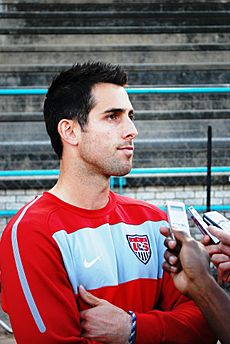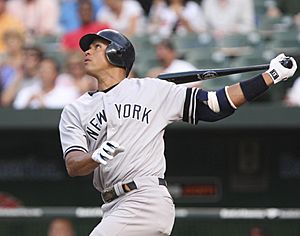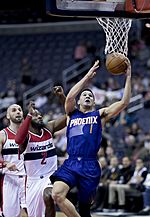Hispanic and Latino athletes in American sports facts for kids
Latinos have had a big impact on American sports in many ways. In baseball, they are the largest minority group, and many Latino players have become huge stars. For example, in 2008, about 27% of all players in Major League Baseball (MLB) were of Latino heritage.
Other sports like basketball, hockey, and American football are also seeing more Latino athletes join in. Even though they are still a smaller group in these leagues, Latinos are definitely making their mark. They show that they are a strong force in many sports and have really helped shape the games they play.
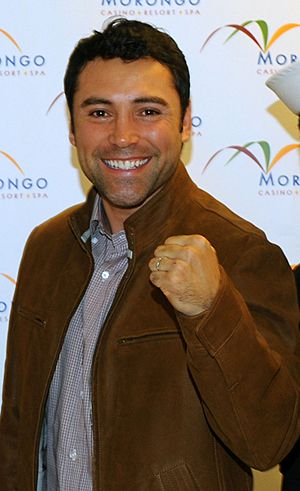
Contents
Soccer: The World's Most Popular Sport
Soccer, also known as fútbol, is the most popular sport around the world. It's also the favorite sport in most Latino countries. The FIFA World Cup is probably the biggest sports event for a single sport on Earth. It brings together soccer players from all over the globe. They compete to see which country can be called the champion.
Since 1930, the World Cup has happened every four years. The only times it didn't were in 1942 and 1946 because of World War II. The very first World Cup was held in a Latino country, Uruguay. Thirteen teams played, and eight of them were from South and Central America. This means more than half the teams were from Latin America. Uruguay won that first World Cup and also won again in 1950.
Only seven countries have ever won the World Cup. Latino countries have won more than their fair share of these titles. Besides Uruguay, other Latino countries that have hosted the event include Chile in 1962 and Mexico in 1970 and 1986. It's clear that Latino countries have played a huge role in the history and growth of the World Cup.
Latino Influence in Major League Soccer
In the United States, Latinos' influence on soccer is perhaps even greater than in other sports. Unlike sports that started in the U.S., fútbol is often linked to Latino countries. In many of these places, it's seen as the main national sport. This strong love for the game is brought to the United States directly by immigrants. Or, it's learned from parents who grew up with the sport.
On the other hand, basketball, baseball, and American football all started in the United States. These sports took time to spread to Latino countries and are sometimes seen as foreign. Soccer, even though it was invented in England, has a much longer history in South America and the rest of the world. This might explain why soccer isn't as popular in the U.S. as it is globally.
One challenge for soccer in the U.S. is that Major League Soccer (MLS) hasn't been as successful as top leagues in other countries. Because of this, not as many top players move to the U.S. to play soccer. The best players usually want to play in leagues in England, Spain, Germany, or Italy. They also want more money. Most MLS salaries in 2008 were below $100,000 a year. This is a very low amount for a professional sport. These reasons make young players dream of playing soccer abroad. Or, they might choose to play a different sport entirely. Few dream of having big careers in the MLS.
There's a lot of potential for soccer to grow in the United States. The easiest way would be to get the Latino community more involved with the MLS. Latinos are now the fastest-growing minority group in the country. So, encouraging them to get more involved could really help the league. There are currently 19 MLS clubs. Two of them are in Canada (Montreal and Toronto). Of the 17 U.S. teams, seven are in areas with many Latinos. Los Angeles has two teams. Chicago, New York, San Jose, Dallas, and Houston also have MLS teams.
Baseball: America's Pastime
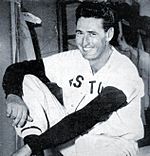
Baseball is known as America's favorite pastime. Recently, people worldwide have seen Latinos not only do well in Major League Baseball (MLB), but also start to dominate it. More and more Latino players are joining the MLB. So, how did Latino communities outside the U.S. begin to play and love this sport?
How Baseball Spread to Latin America
Baseball started after the American colonies became independent from England. For many years, the United States still played cricket, an English game. Many Americans found cricket slow. So, they looked for a faster game, and baseball was created. By the end of the American Civil War, baseball had won the hearts of almost every American. It became the nation's favorite sport.
Soon after it was created, baseball became known in many other countries. For Latin America and the Caribbean, the love for baseball began when two students from Cuba returned home from the United States. They brought a bat and a ball with them. Cuba then helped spread the sport to other Latino countries. Two Cuban brothers brought the game to the Dominican Republic. Cubans, with help from Venezuelans who moved to the U.S., brought the game to Venezuela.
For Mexico and Puerto Rico, baseball spread through both Cubans and people from the United States. In Mexico, it was a mix of Cubans who left the island during its fight for independence. Also, U.S. merchant sailors and railroad workers helped. Puerto Rico likely learned about baseball when the United States took control of the island.
Baseball became a main way for Latinos to fit into American culture. For many young Latinos who come to the United States as immigrants, baseball is a way to connect with people. This includes people of all ages and backgrounds. Baseball helped Latinos express who they were without feeling left out.
However, this didn't stop racial segregation from affecting the sport. Teams were not allowed to have African-American players. So, they looked for other talented players. They recruited Latino and Native American players. This move not only brought in more diverse players but also challenged the racial rules in baseball. Interestingly, some African-American players pretended to be Latinos to get around these rules and play the game. These actions showed how hard people tried to break down the racial barriers in baseball. This eventually helped the sport become integrated.
Little League Baseball and Minor Leagues
Through baseball, Latinos found a new passion they could share with the United States. From a very young age, children in Latin America start playing baseball. Many countries have set up leagues where children can learn the game. They also compete against each other. With the help of Little League Baseball, children from Mexico and Venezuela can play in leagues similar to those in the U.S.
Every year, the best Little League teams from Mexico and Venezuela compete in the Little League World Series. This event takes place in Williamsport, Pennsylvania. In this tournament, countries other than the United States send their best Little League team. They compete in the international bracket. They hope to face an American team in the finals. Since 2009, Mexico and Venezuela have won five Little League World Series titles combined.
All over Latin America, baseball leagues have been created. These leagues allow kids to keep playing as they get older. For example, Mexico, Venezuela, Puerto Rico, and the Dominican Republic all have summer leagues. All these summer leagues are connected to the U.S. Minor League Baseball. The Mexican summer league is the only one of the four that has been given Triple-A status. Triple-A Minor League Baseball is the level right below Major League Baseball. Usually, Major League players who aren't quite ready for the top level play in Triple-A. These leagues are important steps for Latino players. They can make a name for themselves as they try to become Major League Baseball players in the United States.
Famous Latino MLB Players
Roberto Clemente, born in Puerto Rico, is considered one of the best right fielders ever. Many say he's one of the best players in baseball history. He was chosen for the All-Star team 12 times and won 12 Gold Glove Awards. He also won the World Series twice and was the National League MVP in 1966. He was the World Series MVP in 1971. The Pittsburgh Pirates retired his number, 21. He was not only a great player but also a national hero. He died in a plane crash while on a mission to deliver aid to Nicaragua.
Alex Rodriguez, born in the United States, has Dominican roots. He is one of the highest-paid Latino players in the MLB. He was selected for the All-Star team 12 times. He won 10 Silver Slugger Awards, two Gold Glove Awards, and four AL Hank Aaron Awards. He was the AL MVP three times and won a World Series.
Manny Ramirez, born in the Dominican Republic, is another amazing player. He was chosen for the All-Star team 12 times. He won nine Silver Slugger Awards and two AL Hank Aaron Awards. He was a World Series MVP and won the World Series twice. He also led the American League in batting average, home runs, and runs batted in during different years.
For Latinos, playing in the MLB means many things. It's about fame, money, and the love of the game. But most of all, it's a way to fit in and find their identity.
The NBA: Basketball's Big Stage
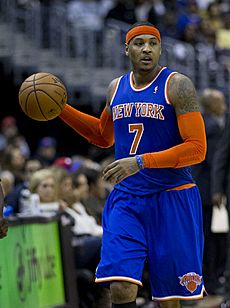
The National Basketball Association (NBA) is the top basketball league in America. For a long time, it was mostly played by white Americans. It wasn't very popular in Latin American countries. That all changed with the arrival of the Nuyoricans. These were Puerto Ricans who had moved to New York looking for a better life. While there, they discovered basketball. They brought the sport back to Puerto Rico, and it became incredibly popular.
For many young Latinos who come to the United States as immigrants, sports are a way to connect with people their own age. This includes people from their own background and other backgrounds. Sports are also a way to bring people together. Even if two people speak different languages, they can both understand the "language" of basketball on the court. Sports helped many Latinos become part of American culture and feel less alone. It also helped Americans realize that Latinos enjoy the same sports they do. Sports even made it possible for many young Americans to have Latino role models. Names like David Ortiz, Manny Ramirez, and Manu Ginóbili are easily recognized by many young people in America, no matter their background. Today, programs like La Liga del Barrio, a youth basketball league in Philadelphia, encourage Latino youth to play sports. They also teach them about discipline and the importance of education.
Basketball in Latin America
One country that really caught basketball fever is the small nation of Belize. Even though it's one of the smaller countries in Central America, it has a very strong love for basketball. The sport is so popular that NBA TV is included in basic cable packages in Belize. In America, NBA TV is a special channel that costs extra.
Basketball became known worldwide in 1992. That year, the American "Dream Team," the name for the Olympic basketball team, easily won all their games at the Olympic Games. The team had the best players America had. Because they won so easily, the rest of the world paid attention. Basketball spread to more cultures than ever before. Since then, the NBA has worked to grow its Latino fan base even more.
The Future of Latinos in the NBA
Because more Latinos are playing and interested in basketball, the NBA has started new marketing programs. They want to make the most of this opportunity.
- Noche Latina
This is a special Latino-themed event put on by the NBA. It happens in cities across the country that have many Latino residents. In 2008, Noche Latina visited Dallas, Houston, San Antonio, Los Angeles, Miami, Phoenix, Chicago, and New York. Each team from these cities wore special jerseys for the night. The team names were translated into Spanish. Besides the uniform changes, the night includes Latino-themed NBA events. These events feature music, food, and other parts of Latino culture. This is a big step for the NBA. It used to be a league mostly with white players. But with the large increase in Latino players and fans, especially in cities like San Antonio, the NBA decided to focus on this market.
- éne•bé•a
The word éne•bé•a is the Spanish translation of "NBA." It's a marketing campaign aimed specifically at Latino NBA fans. By spending time and money to create a separate campaign, the NBA shows the Latino community that it values them as fans and supporters. On the Ene-Be-A website, fans can buy jerseys of their favorite Latino NBA stars. These include Manu Ginóbili and Francisco Garcia.
- Fiesta Lakers
The Los Angeles Lakers play in one of the cities with the most Latinos in the country. Because of this, they have a yearly festival to celebrate the Latino community. It's a city-wide party that involves the Lakers organization and Latino culture. The event started in 2001. Former Laker Mark Madsen was speaking to the mostly Latino crowd after the Lakers' 2001 Championship Parade. Madsen decided to speak to the crowd in Spanish, a skill he learned as a missionary. The crowd's reaction was amazing. Since that day, the Lakers have celebrated the Latino community that supports them every year with a special Latino celebration.
In 2012, the NBA's Minnesota Timberwolves announced a partnership. They teamed up with a Spanish-language radio and television company. This allows them to broadcast some games in Spanish.
Current Latino NBA Players
Manu Ginóbili was born and grew up in Argentina. Many say he is the best Latino player in the NBA today.
Carlos Arroyo is from Puerto Rico. He was the leader of the 2004 Puerto Rican national team. This team defeated the United States team in Olympic play. They were the first country to beat the U.S. in Olympic play since 1992. This was important because basketball was brought to Puerto Rico by people who moved there from the U.S. mainland.
Eduardo Nájera is from Mexico. He first planned to play professional basketball in his home country. But at age 17, he signed a contract with a Mexican League for only $3,000 a month. This was not nearly as much money as he could make in the United States. So, at age 19, he moved to Texas and went to The University of Oklahoma. He became a star basketball player there and was drafted into the NBA. In 2003, he signed a contract worth $24 million. This is something he couldn't have achieved playing basketball in Mexico.
The achievements of these Latino basketball players show that sports are a good way for Latinos to earn a living in a new country. It's also a way to build a positive self-identity. It helps them be recognized across the country as Latino, not just Latino-American. These athletes' successes have brought attention to their heritage and home countries. This increases awareness of Latinos in America.
The NBA also has several Brazilian players. These include Leandro Barbosa, Nené, Anderson Varejão, Tiago Splitter, Fab Melo, and Scott Machado.
American Football: Gridiron Heroes
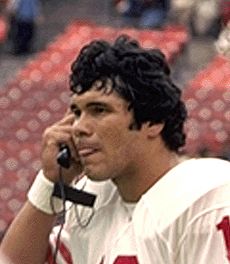
The National Football League (NFL) is the main American football league in the United States. American football is very popular in the U.S., but not as much worldwide. There is a smaller percentage of Latinos in the NFL. Currently, there are only 24 Latino players in the league.
The first Latino quarterback to win a Super Bowl was Jim Plunkett. He won seven years before Doug Williams became the first black quarterback to win a Super Bowl. The first Latino coach to win a Super Bowl was Tom Flores. He also won before the first black coach, Tony Dungy, won a Super Bowl. And the first Latino player in the league, Joe Aguirre, joined before Kenny Washington and Woody Strode became the first black players to play in the league.
Tony Romo was the main quarterback for the Dallas Cowboys from 2006 to 2015. He led the team to the playoffs four times and was chosen for the Pro Bowl four times. Sammis Reyes, the first Chilean player in the league, grew up playing basketball. He was a youth member of the Chilean national basketball team. He moved to the United States at age 14 after getting a sports scholarship. Reyes played college basketball before switching to football. He signed with the Washington Football Team in 2021.
Motorsports: Fast and Furious
In the 1980s, Brazilian drivers started competing in IndyCar races. Emerson Fittipaldi, Hélio Castroneves, Tony Kanaan, Gil de Ferran, and Cristiano da Matta won many races and championships. Mexicans like Adrián Fernández, Memo Rojas, Luis Díaz, and Sergio Perez have also done well in formula racing and sports car racing. Daniel Suárez was the 2016 NASCAR Xfinity Series champion.
A few Colombian drivers also had success in North American motorsport. Roberto Guerrero won two races and finished on the podium ten times in CART. Juan Pablo Montoya won the CART title in 1999. He later won races in NASCAR and sports car racing. Carlos Muñoz finished second twice in the Indianapolis 500. Also, Argentine racer Juan Manuel Fangio II won two IMSA GTP championships.
Cuban-American businessman Felix Sabates is a co-owner of Chip Ganassi Racing, a well-known racing team.
Other Sports: Beyond the Big Leagues
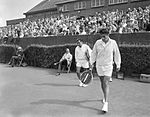
Nancy Lopez is a professional golfer. She grew up in Roswell, New Mexico, and her parents were of Mexican heritage. When she was young, she loved golf. But she wasn't allowed to play at her local golf club because of her ethnicity. She eventually moved out of Roswell and went on to win many awards as a golfer. She is currently the youngest golfer ever to be inducted into the LPGA Hall of Fame.
Mexican golfer Lorena Ochoa moved to the United States to attend the University of Arizona. She wanted to continue her golf career. Her parents saw golf as a chance for her to earn money and find success in America. She became so good at golf that in 2004, she became the first Mexican-born player to win an LPGA event. That same year, the Mexican president at the time, Vicente Fox, gave her the "Premio Nacional de Deporte," which is the National Sports Award.
See also
- Hispanic and Latino Americans
- Latinos In Action Sports Association


